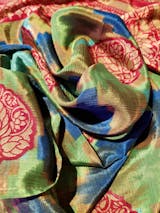The Impact of Sustainable Fashion on the Environment
Let’s be real: the fashion industry has a not-so-glamorous secret. While it churns out those cute outfits we all love, it’s also one of the most harmful industries to our planet. The environmental toll is staggering, with fast fashion leading the charge. Enter sustainable fashion, a concept that’s gaining momentum as people become more eco-conscious.
But what exactly is sustainability in fashion, and why should you care? Spoiler alert: it’s about making choices that look good on you and the planet.
Let’s dive into how this shift is changing the game for both wardrobes and the environment.
The Dark Side of Fast Fashion
We’ve all been there—scrolling through an online sale, grabbing trendy pieces at shockingly low prices. Fast fashion makes it easy to update your look without breaking the bank. But here’s the catch: it’s terrible for the environment.
Fast fashion operates on a cycle of overproduction, waste, and pollution. Think about it: millions of clothes end up in landfills every year because they’re cheaply made and fall apart after a few wears. Plus, the water needed to produce a single pair of jeans? Around 2,000 gallons. That’s enough for you to drink for years!
Let’s not even start on the pollution. Synthetic fabrics like polyester shed microplastics every time they’re washed, sneaking into oceans and harming marine life. The problem doesn’t stop there—cheap dyes pollute rivers, and the energy used in production leaves a massive carbon footprint.
But wait, there’s more. Fast fashion also has a human cost. Workers in unsafe conditions, paid unfairly, often produce these cheap clothes.
It’s not just the environment that’s paying the price—it’s people too.
What Does Sustainable Fashion Really Mean?
So, what’s the alternative? Sustainable fashion offers a way forward by focusing on long-term solutions over quick fixes. Here’s what sets it apart:
Eco-friendly materials
Think organic cotton, hemp, or recycled fabrics. These materials are grown or sourced with minimal harm to the planet.
Ethical production
This means safe working conditions, fair wages, and transparency in how clothes are made.
Durability
Sustainability in fashion isn’t about endless consumption—it’s about investing in high-quality pieces that last longer.
Circular fashion
Buying secondhand, renting clothes, or upcycling are ways to keep garments in use longer and reduce waste.
How Sustainable Fashion Helps the Environment
Let’s break down how sustainability in fashion makes a real difference:
Reducing Waste
Fast fashion’s “wear once, toss out” culture leads to overflowing landfills. Sustainable choices—like thrift shopping or buying from fashion brands that are sustainable—help minimize waste. Imagine if every piece of clothing was loved and reused instead of tossed!
Saving Water and Energy
Traditional fashion production guzzles water and uses energy-intensive processes. Sustainable practices focus on low-impact techniques, like waterless dyeing or using renewable energy.
Cutting Pollution
By avoiding toxic dyes and synthetic fabrics, sustainable fashion keeps harmful chemicals out of rivers and oceans. The result? Cleaner water and healthier ecosystems.
Promoting Biodiversity
Fast fashion’s reliance on pesticides and fertilizers for cotton farming harms soil and wildlife. Switching to organic materials reduces these threats and supports a thriving environment.
Debunking Myths About Sustainable Fashion
Let’s address the elephant in the room: the myths surrounding sustainable fashion. Some people think it’s too expensive or not stylish enough. But guess what? That’s not true!
-
“It’s too pricey.” While some sustainable pieces are more expensive upfront, they’re an investment. These clothes last longer, saving you money in the long run. And there are affordable fashion brands that are sustainable, so you don’t have to break the bank.
-
“It’s not trendy.” Sustainable doesn’t mean boring! Many brands offer chic, timeless designs or even trendy collections with an eco-friendly twist.
-
“One person can’t make a difference.” Every choice counts. When you support sustainability in fashion, you’re voting with your wallet and encouraging brands to do better.
How You Can Join the Movement
Feeling inspired but not sure where to start? Don’t worry—it’s easier than you think! Here are some simple ways to embrace sustainable fashion:
Thrift It Out
Secondhand shopping is a fun way to score unique finds while giving clothes a second life. You’ll save money and help reduce waste.
Buy Quality, Not Quantity
Focus on timeless, well-made pieces from fashion brands that are sustainable. They’ll last longer and save you from constantly replacing your wardrobe.
Care for Your Clothes
Washing in cold water, air-drying, and repairing minor tears can extend the life of your clothes. It’s all about making what you have last.
Host Clothing Swaps
Gather your friends and trade clothes you’re tired of for something fresh. It’s fun, sustainable, and free!
Sustainable Fashion Goes Beyond Clothes
This movement isn’t just about what you wear—it’s about how you live. Choosing sustainability in fashion is part of a broader shift toward protecting the planet. It connects to other eco-friendly habits like reducing plastic use, conserving energy, and eating locally.
And the best part? Your choices inspire others. When someone compliments your outfit, it’s a chance to talk about why you support fashion brands that are sustainable. It’s like planting little seeds of change.
Progress Over Perfection
At Darn Good Yarn, we know sustainable fashion is about progress, not perfection. You don’t need to overhaul your wardrobe overnight to make a difference. Small, mindful choices—like thrifting or supporting ethical brands—can add up to big change.
That’s where we come in. We’re passionate about organic fashion that looks good, feels good, and does good. From vibrant, handcrafted clothing to eco-friendly yarns, our products are made with care for the planet and the people behind them. Many of our items, like our signature sari wraps, are crafted from recycled materials, giving new life to what would otherwise be waste.
Ready to take the first step? Browse our products and join us in making better choices for the planet—because together, we can make a difference.
And doesn’t that look good on everyone?
 Rewards
Rewards


























